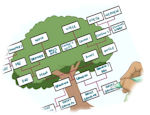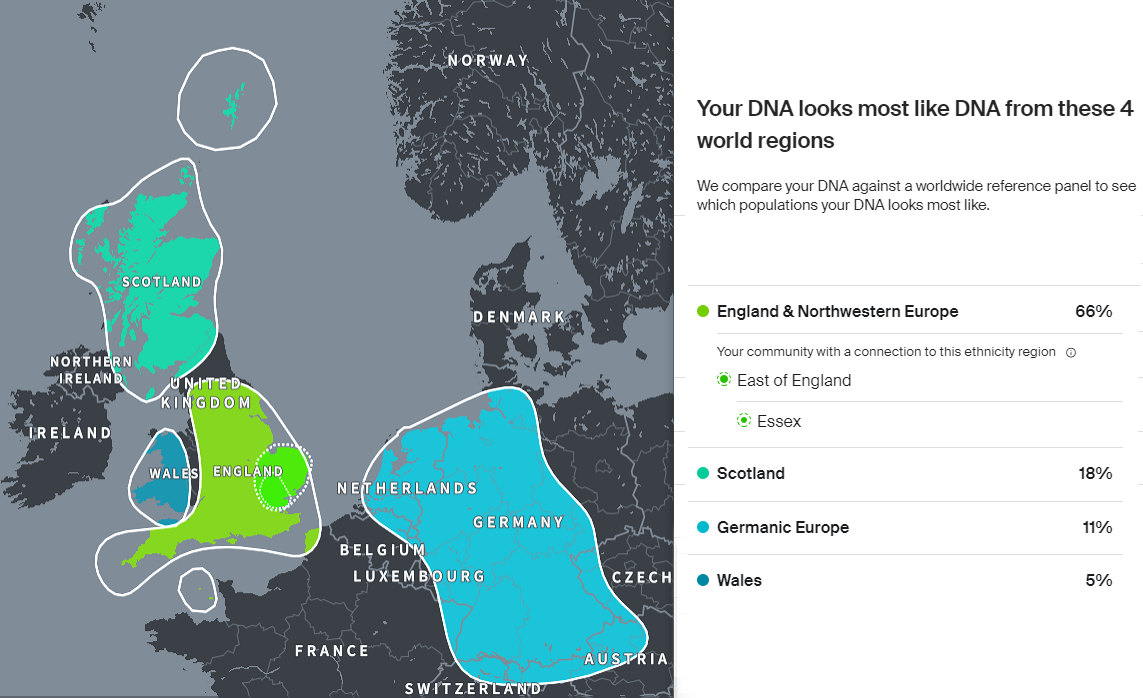Apprehension |
Ken's Results |
DNA Matching (Ken) |
Discoveries 1 | 2 | 3 | 4 |
Why would DNA matching bring apprehension to our lives? It wasn't the people on the family tree that caused concern. It was, however, over four decades of certainty that was under threat that created our angst.
 Oral tradition. We started our genealogical research in the late 1970s. This was prompted by the birth of our first child for whom we had chosen two names - one for a boy and one for a girl. When speaking with one of Teresa's aunts, she asked why we had chosen those names. We replied that we had done so because they were uncomplicated names and hadn't been used before in our families, as far as we knew. Teresa's aunt knew better and informed us that Teresa's Oldridge great grandparents had the two names we had chosen. Intrigued by the coincidence, we wanted to know more.
Oral tradition. We started our genealogical research in the late 1970s. This was prompted by the birth of our first child for whom we had chosen two names - one for a boy and one for a girl. When speaking with one of Teresa's aunts, she asked why we had chosen those names. We replied that we had done so because they were uncomplicated names and hadn't been used before in our families, as far as we knew. Teresa's aunt knew better and informed us that Teresa's Oldridge great grandparents had the two names we had chosen. Intrigued by the coincidence, we wanted to know more.
 Documentation. Having asked as many people as possible about our heritage and recorded that on pieces of paper, this became our first layer of information. The next layer to overlay on this was validation of the stories we had heard by gathering relevant documentation. This was in the form of certificates, census returns and any other documents that would help fill out the narrative. We visited dusty, poorly financed and uncoordinated record depositories scattered across the country. By the start of the 21st century, however, new tools had been developed that improved the process of gathering, recording and sharing the knowledge we had acquired. These tools were computer based genealogy programmes and the world wide web.
Documentation. Having asked as many people as possible about our heritage and recorded that on pieces of paper, this became our first layer of information. The next layer to overlay on this was validation of the stories we had heard by gathering relevant documentation. This was in the form of certificates, census returns and any other documents that would help fill out the narrative. We visited dusty, poorly financed and uncoordinated record depositories scattered across the country. By the start of the 21st century, however, new tools had been developed that improved the process of gathering, recording and sharing the knowledge we had acquired. These tools were computer based genealogy programmes and the world wide web.
 Information Technology. Embracing the new technologies for genealogy became increasingly simple and less expensive as time went by. We gradually stopped writing letters to distant parts of the world in order to contact potential relatives. The documentation layer of our research was becoming more comprehensive as time went by. This had confirmed most of the oral versions of our family histories, had confounded only small and relatively inconsequential aspects of the stories we had been told and, most importantly, provided some level of reassurance that we were on the right track.
Information Technology. Embracing the new technologies for genealogy became increasingly simple and less expensive as time went by. We gradually stopped writing letters to distant parts of the world in order to contact potential relatives. The documentation layer of our research was becoming more comprehensive as time went by. This had confirmed most of the oral versions of our family histories, had confounded only small and relatively inconsequential aspects of the stories we had been told and, most importantly, provided some level of reassurance that we were on the right track.
DNA Matching. Science had afforded us all the advantages described above, but then introduced a threat to the validity of the stories we had pieced together. DNA analysis for genealogical matching became widely available and, if invoked, could readily bring almost half a century's efforts crumbling into dust - but only if it disproved the leads we had been following. DNA became the third, and indisputable, layer of evidence, lain atop the documentation which in turn was atop the stories passed down by word of mouth. This is where the apprehension, which is the subject of this section, arose. Half a lifetime's research was at risk.
A crumb of comfort came in 2021 when Teresa's brother arranged for his DNA to be analysed by 23&Me. He shared the results with us and from what we could glean, there was little threat to our documented stories. Indeed, it confirmed what we understood to be Teresa's and her brother's genealogy. In October 2022, after much deliberation, we agreed to get Ken's DNA tested for genealogical purposes by Ancestry.com. As will be seen from the content elsewhere on this website, our concerns were unfounded. The family histories we had built were validated and years of research and expense were vindicated. It was an enormous relief.
We are now looking forward to sending Teresa's DNA for analysis to Ancestry.com at some time in the near future (written May 2023). The DNA results from this company are derived from a larger database and are easy to work with, now that we have the experience. As we have done with Ken's test, we shall upload Teresa's results to GedMatch, FTDNA and other companies to ensure a greater spread of matching on other databases.
Ken's Results |
 Ancestry.com report |
The 18% showing for Scotland reflects the ancestry of Ken's mother, the Bullion family having come from Perthshire. Germanic Europe is a mystery as no evidence has been found for any ancestral line to have come from continental Europe at all, neither from documents nor DNA matching. Similarly, there is no evidence for any connection with Wales but this is a Celtic nation and a well documented connection with Cornwall (shown on the map with the letter "C") is known. It has been suggested by many contributors on internet forums that because the Cornish nation is small and being part of the Celtic group that their Cornish ancestry is frequently subsumed into other Celtic nations.The indicated level of DNA matching at 5% is not inconsistent with the fact that Ken's four times great grandfather came to London in 1795 and no other Cornish DNA has been added since then, six generations ago. |
DNA Matching - Ken's ancestors |
 Tracking Ken's DNA matches over the generations to their respective earliest common ancestors |
|
The ancestries of over 100 people sharing a DNA match with Ken have been traced back through the generations to the point where their common ancestor can be identified. Each ancestral line is represented on the above chart which indicates the extent of DNA matching for each line, along with the earliest documented ancestors for each line. Understanding the chart:
* The fact that no Rogers DNA match has been identified could be because no descendant has yet had their DNA tested and published. It is also possible that the stated parents (#5621) of #5656 on this line were not the true biological parents. |
DiscoveriesAlthough we have been researching across five decades the DNA matching process has revealed three branches of Ken's family that we never knew existed. The story of each discovery is told below. We remain in touch with the cousins we have 'discovered' and if you wish to know more or want to contact them, please e-mail us.
|
|
|
|
|
|
|
|
|